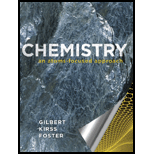
To find:
The energies corresponding to radiation in the visible region of the spectrum for the given nitride ceramics.
Answer to Problem 18.33QA
Solution:
Explanation of Solution
1) Concept:
To find the wavelength corresponding to the visible regions, we need to use the
2) Formula:
3) Given:
i)
ii)
iii)
iv)
v)
vi) Avogadro’s number,
4) Calculations:
a) The energy gap is the minimum energy needed to excite the electrons from the ground state for the conduction. From this energy, we can calculate the light energy needed to excite the electrons from their ground state to conduction band.
First we will calculate the energy, J/photons, by using Avogadro’s number.
Wavelength of
Since the wavelength of
b) Wavelength of
First we will calculate the energy, J/photons, by using Avogadro’s number.
Wavelength of
Since the wavelength of
c) Wavelength of
First we will calculate the energy, J/photons, by using Avogadro’s number.
Wavelength of
Since the wavelength of
Conclusion:
The wavelength is calculated from the energy gaps present in the semiconductors and Avogadro’s value.
Want to see more full solutions like this?
Chapter 18 Solutions
Chemistry: An Atoms-Focused Approach
 ChemistryChemistryISBN:9781305957404Author:Steven S. Zumdahl, Susan A. Zumdahl, Donald J. DeCostePublisher:Cengage Learning
ChemistryChemistryISBN:9781305957404Author:Steven S. Zumdahl, Susan A. Zumdahl, Donald J. DeCostePublisher:Cengage Learning ChemistryChemistryISBN:9781259911156Author:Raymond Chang Dr., Jason Overby ProfessorPublisher:McGraw-Hill Education
ChemistryChemistryISBN:9781259911156Author:Raymond Chang Dr., Jason Overby ProfessorPublisher:McGraw-Hill Education Principles of Instrumental AnalysisChemistryISBN:9781305577213Author:Douglas A. Skoog, F. James Holler, Stanley R. CrouchPublisher:Cengage Learning
Principles of Instrumental AnalysisChemistryISBN:9781305577213Author:Douglas A. Skoog, F. James Holler, Stanley R. CrouchPublisher:Cengage Learning Organic ChemistryChemistryISBN:9780078021558Author:Janice Gorzynski Smith Dr.Publisher:McGraw-Hill Education
Organic ChemistryChemistryISBN:9780078021558Author:Janice Gorzynski Smith Dr.Publisher:McGraw-Hill Education Chemistry: Principles and ReactionsChemistryISBN:9781305079373Author:William L. Masterton, Cecile N. HurleyPublisher:Cengage Learning
Chemistry: Principles and ReactionsChemistryISBN:9781305079373Author:William L. Masterton, Cecile N. HurleyPublisher:Cengage Learning Elementary Principles of Chemical Processes, Bind...ChemistryISBN:9781118431221Author:Richard M. Felder, Ronald W. Rousseau, Lisa G. BullardPublisher:WILEY
Elementary Principles of Chemical Processes, Bind...ChemistryISBN:9781118431221Author:Richard M. Felder, Ronald W. Rousseau, Lisa G. BullardPublisher:WILEY





